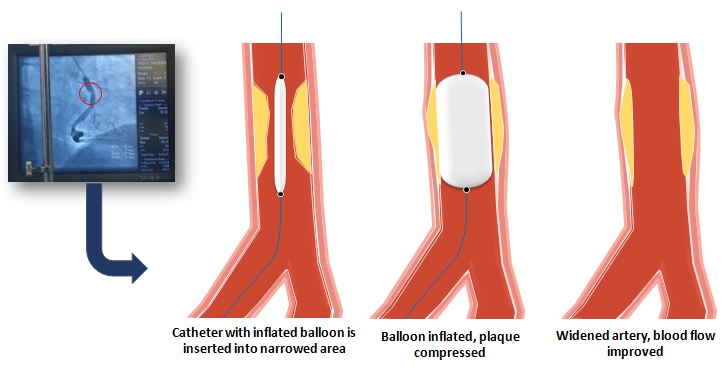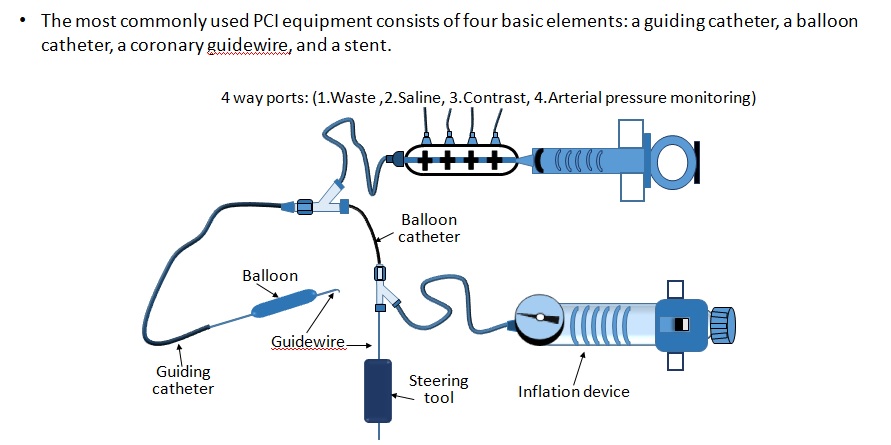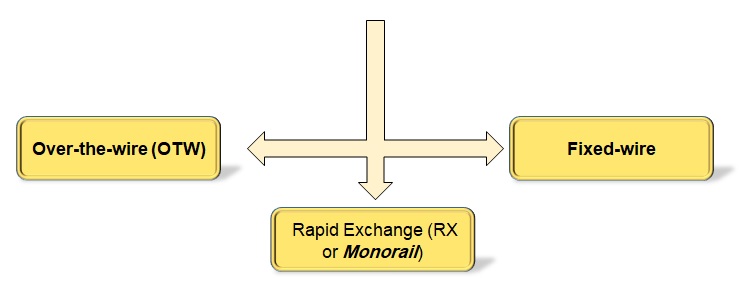Balloon
- What is a balloon and PCI?
- PCI Equipment
- Balloon overview
- Compliance
- Types of PCI balloon catheters
Balloon
- An angioplasty balloon is a medical device that is attached at the end of a special balloon catheter, the balloon is at one end and can be inflated/deflated from the other end outside the body.
- The balloon catheter will send over a guidewire into a a narrow or blocked artery with a fatty substance (plaque).
- An interventional cardiologist inflated and deflated the balloon several times to restore blood flow in the artery by pushing the plaque aside.
- The other option of the balloon is to open up the stent when it is positioned in the desired place.
- Another kind of balloon called cutting balloon is a special balloon containing small blades that are activated when it is inflated. The small blades cut slits in the plaque that is resistant to a traditional balloon, and then pushes the fatty substance into the wall of the artery.


PCI Equipment
- The most commonly used PCI equipment consists of four basic elements: a guiding catheter, a balloon catheter, a coronary guidewire, and a stent.

Balloon Overview

Compliance
Definition: the degree of increase in balloon diameter as the inflation pressure increases.
Compliant:
- Diameter increases in ratio with the increase in inflation force
- Can increase their diameter 10-15% above their nominals when the inflation pressure reaches bursting pressure (which is usually low)
- Size of balloon may grow beyond the ceiling of clinical safety
Non-compliant:
- Reach and maintain specified size regardless of inflation pressure
- Little to no flexibility in vessel sizing
- The non-compliant balloons can only reach less than 5% above their nominal sizes at their burst pressure (which is usually high)
Semi-compliant:
- Wide working pressure range with controlled flexibility in balloon sizing

There are three types of PCI balloon catheters:

Over-The-Wire (OTW) Balloon Catheters
- Classical balloon catheters which have two lumens running through the entire course of balloon catheter.
- One lumen is for passage of guidewire
- Other lumen for connecting with an indeflator (for balloon inflation/deflation)
 Balloon Catheters.jpg)
OTW
Advantages
- Continuous guidewire support
- Greater push for distal anatomy
- Wire exchange during difficult cases through lumen without removing catheter
Disadvantages
- Long 300 cm wire necessary (or wire extension for 180 cm wires)
- Usually needs 2nd operator
- Can take more time, requiring more fluoroscopy
Specific Uses:
- Treatment of complex lesions where the following may be required:
- Added wire support
- Easy exchange of wires
- Extra catheter pushability
- Intracoronary injections
Rapid Exchange (Rx) Delivery System
- Rapid-exchange (RX) or monorail balloon catheters have become the current standard for percutaneous coronary interventions (PCI).
- This balloon catheter also contain two lumens, but guidewire lumen does not extend along the entire course of the balloon.
- It starts from distal end but finishes well before the proximal end of the balloon catheter.
 Delivery System.jpg)
Rx
Advantages
- Quick balloon exchanges
- Requires only a single operator
- Greater operator control of wire
- Less fluoro and procedural time
- Lower doses of contrast medium
- Smaller device diameters
Disadvantages
- Inability to exchange wires w/o removing the entire system
- Inability to switch to an OTW system w/o exchanging the
- guidewirePushability may be compromised due to the short wire lumen
Specific Uses:
- This type of system is ideal for simpler cases, where the extra wire support is not needed.
Fixed-wire
- It has the inelastic balloon wrapped around a central hollow wire(guidewire) with a distal flexible steering tip.
- The proximal end of the catheter consists of a single port connected to a thin metal tube (hypotube) used to inflate the balloon. A core wire extends from the hypotube to the end of the distal steerable tip.
- The guidewire attached to the balloon can be rotated freely, but it cannot advance independently of the balloon.
- This assembly is coated with a thin plastic shaft that enhances flexibility. Fixed-wire balloons have only one enclosed lumen for balloon inflation.
- This system is generally not considered for first-line use due to the lack of pushability, trackability, and steerability. However, because of its extremely low profile, it may occasionally cross tight narrowing when over-the-wire balloons fail.
